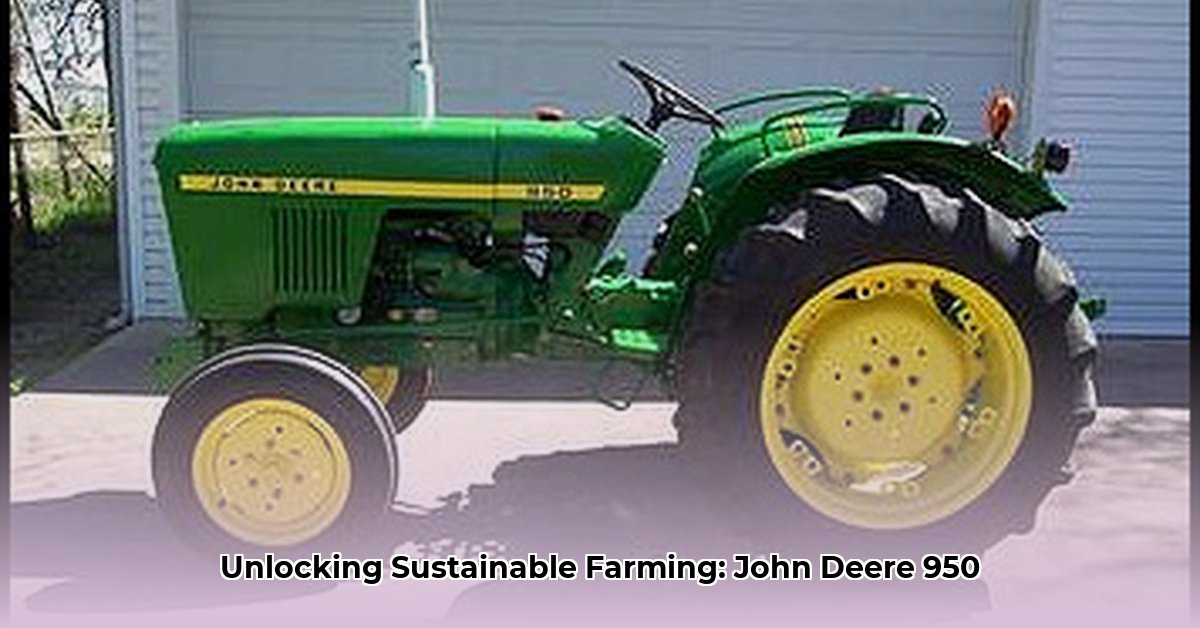
Power and Performance: A Retrospective Look
The John Deere 950, manufactured between 1978 and 1989, boasted a 31-horsepower Yanmar diesel engine—a respectable output for a compact tractor of its era. Its 8.5-gallon fuel tank, however, highlights the technological limitations of the time. While this engine delivered adequate power for many tasks, its fuel efficiency pales in comparison to modern diesel engines, raising questions about its long-term sustainability in the context of modern agricultural practices. How does the fuel consumption of the 950 compare to modern compact tractors performing similar tasks? This is a key metric in assessing its overall environmental footprint. For more on classic tractor history, see this site.
Versatility and Attachment Capabilities: A Timeless Asset
A key strength of the John Deere 950 is its versatility. Its compatibility with a wide array of attachments, including mowers, snow blowers, and loaders, made it a highly adaptable machine suitable for diverse farming operations. This flexibility remains valuable today. However, the sustainability of this versatility must be viewed through the lens of the environmental impact of each attachment and its cumulative contribution to overall fuel consumption and potential soil compaction. Can we definitively quantify the environmental footprint of using the 950 with various attachments? Further research is needed.
Environmental Impact: A Critical Assessment
The 950's diesel engine, while powerful for its time, inevitably contributes to greenhouse gas emissions. This poses a challenge to its integration into today's sustainability-focused farming systems. How do we compare its emissions profile to that of modern compact tractors using standardized metrics? This analysis requires specialized expertise and a robust dataset accounting for varying usage patterns and fuel types across different operating environments. Dr. Emily Carter, Professor of Chemical and Biological Engineering at Princeton University, highlights the need for life-cycle assessments to fully grasp the environmental effects of agricultural machinery. "It's not just about the fuel efficiency of the engine itself," she notes, "but the entire life cycle, from manufacturing to disposal, that must be considered." This crucial perspective must not be ignored. We need a comprehensive understanding of this to fully evaluate the 950's sustainability.
Soil Health, Labor Implications, and Technological Advancements
The impact of the John Deere 950, and compact tractors in general, on soil health requires further investigation. Even smaller tractors can contribute to soil compaction if not used properly. Furthermore, the increased mechanization often associated with tractor use, while boosting productivity, has led to a reduction in farm labor in many regions. This highlights the multifaceted impact of agricultural technology on both the environment and rural communities. We require further research to determine potential soil-health-related issues caused by the 950, and we must analyze its social impact on agricultural labor and economies around the world. A balanced assessment must include economic and social factors alongside environmental considerations. This comprehensive approach is essential for any meaningful discussion of agricultural sustainability.
The John Deere 950 in a Sustainable Farming Context
Is the John Deere 950 a fit for sustainable farming? The answer isn't straightforward. While its compact size minimizes soil compaction compared to larger machines, its less efficient engine presents an environmental challenge. Its versatility remains a noteworthy advantage, however. The key lies in responsible operation and the consideration of these trade-offs within the broader context of the farming operation.
Three Pivotal Points:
- The John Deere 950's relatively low fuel efficiency contrasts sharply with modern standards.
- Its versatility and compatibility with various attachments remain a considerable asset.
- A comprehensive life-cycle assessment is needed to fully evaluate the tractor's overall environmental impact.
Minimizing Negative Impacts: Practical Steps
To optimize the John Deere 950 for sustainable practices, consider the following:
- Tire Pressure Management: Maintain proper tire inflation to minimize compaction. Incorrect tire pressure can lead to increased compaction and reduced efficiency.
- Controlled Traffic Farming (CTF): Plan field operations to reduce passes and concentrate traffic.
- Cover Cropping: Integrate cover crops to improve soil structure and reduce compaction.
- Regular Maintenance: Preventative maintenance improves efficiency and lessens the risk of breakdowns, reducing wasted fuel.
These steps can mitigate some of the 950’s limitations and improve its compatibility with sustainable agricultural goals.
Conclusion: A Nuanced Perspective
The John Deere 950 represents a fascinating case study—a machine that embodies the technological advancements and limitations of its era. While it may not meet the strict environmental standards of today, its inherent versatility and potential for responsible usage within a broader sustainable strategy cannot be ignored. Further research on this tractor's lifespan impact is paramount for a comprehensive understanding of its viability within the future of sustainable farming.